Viking VQGFS5541NSS, VQGFS5361NSS, VQGFS5301NSS Maintance Manual
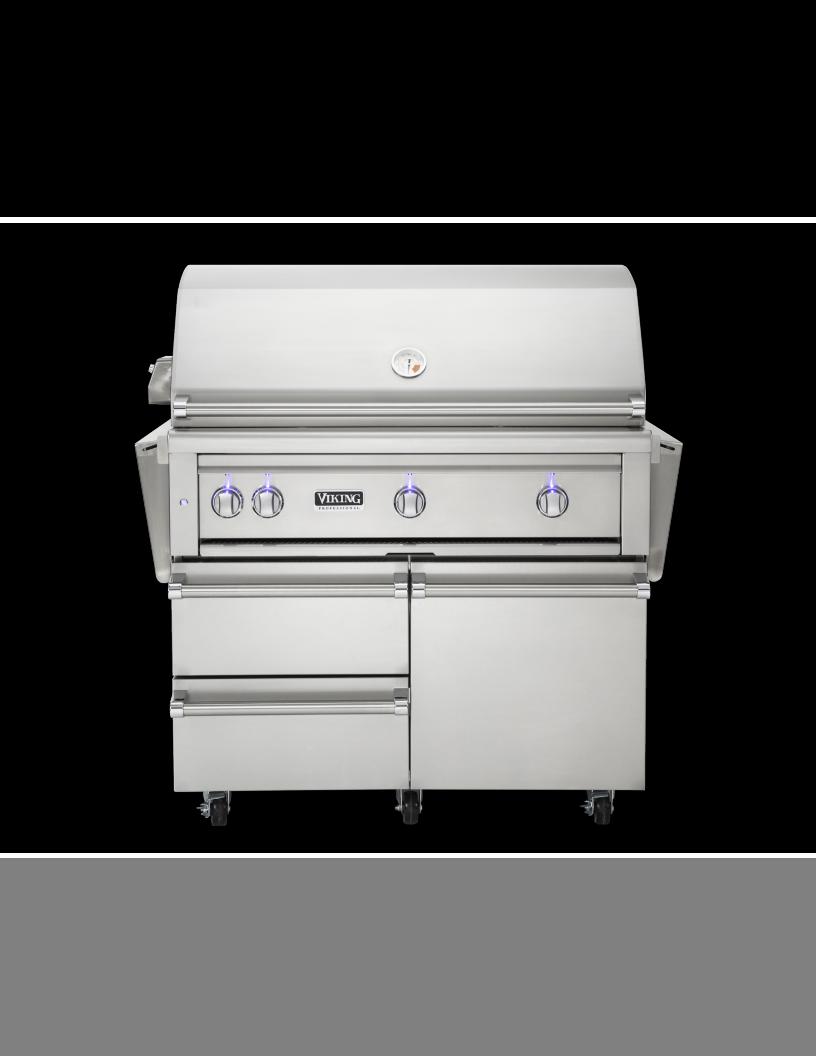
PROFESSIONAL OUTDOOR GRILLS
INSTALLATION/CARE & USE
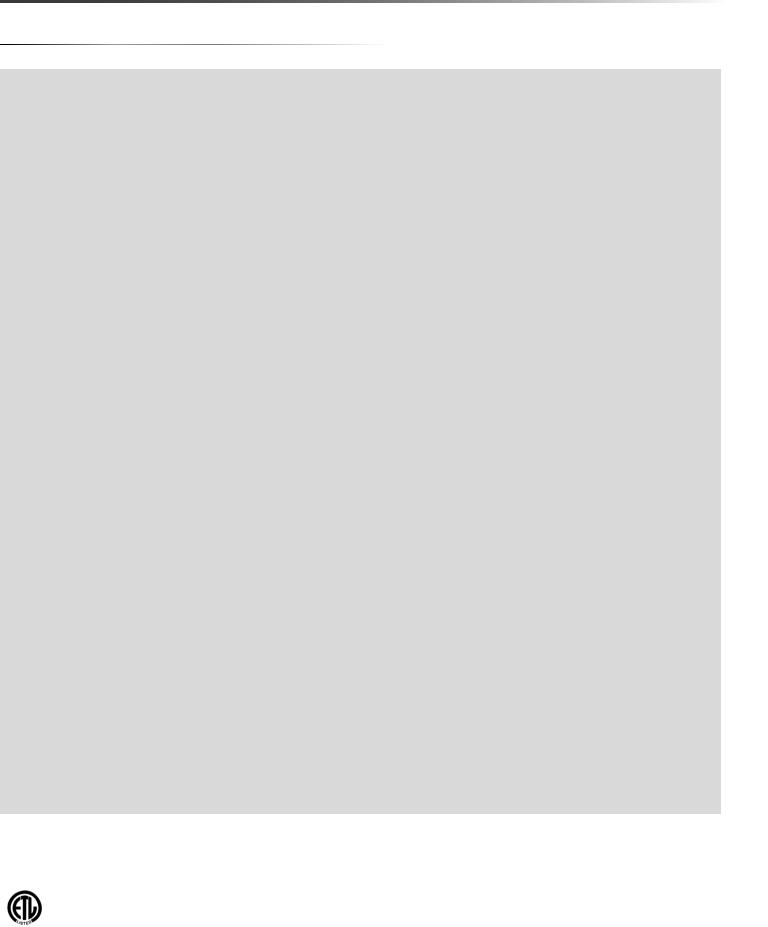
WARNINGS
 WARNING
WARNING
•Never use dented, rusty or damaged propane cylinders. Never store additional or empty propane cylinders in the grill cabinet or in the vicinity of this or any other appliance. Do not store propane cylinders indoors or on their sides.
•Children should never be left alone or unattended in an area where a grill is located. Place your grill well away from areas where children play. Do not store items that may interest children in or around the grill, in the cart, or in the masonry enclosure.
•Never move the grill when hot. When in use, portions of the grill are hot enough to cause severe burns.
•Always maintain the required clearances from combustibles as detailed. The grill is designed for outdoor use only. Never use in a garage, building, shed, breezeway, or other enclosed area. Do not use this grill under any unprotected overhead combustible construction.
•Gas grills are not designed or certified for and are not to be installed in or on recreational vehicles, portable trailers, boats or any other moving installation.
•Always have an ABC Fire Extinguisher accessible — never attempt to extinguish a grease fire with water or other liquids.
•Storing your grill: Store your grill in a well-ventilated area. If stored indoors, detach and leave L.P. cylinder outdoors in a well-ventilated area away from heat and away from where children may tamper with it.
•Keep any electrical supply cord and the fuel supply hose away from any heated surfaces. Electrical cords should be placed away from walkways to avoid tripping hazard.
•Do not repair or replace any part of the grill unless specifically recommended in this manual. Other service should be performed by a qualified technician.
•If the grill is installed by a professional installer or technician, be sure that he/she shows you where your gas supply shut-off is located. All gas lines must have a shut-off that is readily and easily accessible. If you smell gas, check for gas leaks immediately. Check only with a soap and water solution. (See INDEX: “Leak Testing” for further details.) Never check for gas leaks with an open flame.
•Inspect the L.P. gas supply hose prior to each use of the grill. If there is evidence of excessive abrasion or wear, or the hose is cut, it must be replaced before using the grill.
•Never remove the grounding prong from the plug or use this product with an ungrounded, 2-prong adapter.
THIS MANUAL MUST REMAIN WITH THE PRODUCT OWNER FOR FUTURE REFERENCE.
This product complies with ANSI standard Z21.58/CSA 1.6 latest edition and has been tested and approved by Intertek.
To obtain replacement parts or service contact:
Viking Range, LLC Preferred Customer Service 111 Front Street
Greenwood, Mississippi 38930 Service: (888) 845-4641
2 | CARE & USE/INSTALLATION
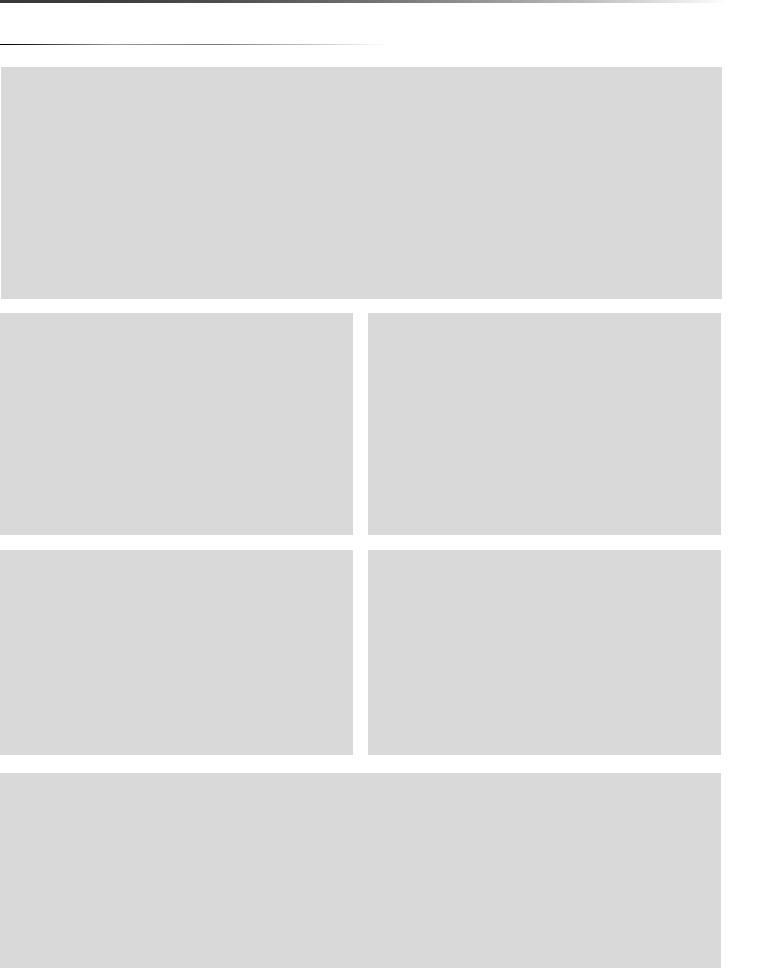
WARNINGS
 WARNING
WARNING
READ THIS MANUAL CAREFULLY and completely before using your grill to reduce the risk of:
1.Fire
2.Burn hazard, personal injury or property damage
3.Ruined steaks or other unpleasant cooking experiences
4.Unapproved installation or servicing.
THIS PRODUCT IS DESIGNED FOR OUTDOOR USE ONLY. Improper installation, adjustment, alteration, service or maintenance can cause property damage, injury or death.
Read this manual thoroughly before installation, use, or servicing of this product.
 DANGER
DANGER
IF YOU SMELL GAS:
1.Shut off all gas supply lines to the grill.
2.Extinguish any open flames.
3.Carefully open the lid. Remember, it may be extremely hot!
4.If odor continues, keep everyone away from the grill and immediately call your gas supplier or your fire department.
 DANGER
DANGER
S’IL Y A UNE ODEUR DE GAZ:
1.Coupez l’admission de gaz de l’appariel.
2.Éteindre toute flamme nue.
3.Ouvrir le couvercle.
4.Si l’odeur persiste, éloignez-vous de l’appareil et appelez immédiatement le fournisseur de gaz ou le service d’incendie.
 WARNING
WARNING
1.DO NOT store or use gasoline or other flammable vapors and liquids in the vicinity of this or any other appliance.
2.An LP cylinder not connected for use shall not be stored in the vicinity of this or any other appliance.
 AVERTISSMENT
AVERTISSMENT
1.Ne pas entreposer ni utiliser de l’essence ni d’autres vapeurs ou liquides inflammables dans le voisinage de l’appareil, ni de tout autre appareil.
2.Une bouteille de propane qui n’est pas raccordée en vue de son utilisation, ne doit pas être entreposée dans le voisinage de cet appareil ou de tout autre appareil.
 WARNING! CALIFORNIA PROPOSITION 65
WARNING! CALIFORNIA PROPOSITION 65
1.The burning of gas cooking fuel generates some by-products which are on the list of substances which are known by the State of California to cause cancer or reproductive harm.
2.California law requires businesses to warn customers of potential exposure to such substances. To minimize exposure to the substances, always operate this unit according to the use and care instructions found in this manual. Be certain to provide adequate ventilation when cooking.
CARE & USE/INSTALLATION | 3

WARNINGS
 WARNING
WARNING
1.Always maintain the required clearances from combustible construction as detailed. The grill is designed for outdoor use only. Never use in a garage, building, shed, breezeway or other enclosed area. This grill shall not be used under any unprotected overhead combustible construction.
2.Gas grills are not design certified for and are not to be installed in or on recreational vehicles, portable trailers, boats or any other moving installation.
3.Keep any electrical supply cord and the fuel supply hose away from any heated surfaces. Electrical cords should be placed away from walkways to avoid creating a tripping hazard.
4.Do not repair or replace any part of the grill unless specifically recommended in this manual. Other service should be performed by a qualified technician.
5.All gas lines must have a shut-off that is readily and easily accessible. Be sure the owner knows where the shut-off is located. If you smell gas, check for gas leaks immediately. Check only with a soap and water solution. Never check for gas leaks with an open flame. (See INDEX: “Leak Testing” for further details.)
 WARNING
WARNING
1.The outdoor cooking gas appliance and its individual shutoff valve must be disconnected from the gas supply piping system during any pressure testing of that system at test pressures in excess of 0.5 psi (3.5 kPa).
2.The outdoor cooking gas appliance must be isolated from the gas supply piping system by closing its individual manual shutoff valve during any pressure testing of the gas supply piping system at test pressures equal to or less than 1/2 psi (3.5 kPa).
 STATE OF MASSACHUSETTS
STATE OF MASSACHUSETTS
1.Massachusetts requires all gas be installed using a plumber or gas fitter carrying the appropriate Massachusetts license.
2.All permanently-installed natural gas or propane installations require a “T” handle type manual gas valve be installed in the gas supply line to this appliance.
3.This does not apply to portable propane installations using a 20 pound cylinder.
4 | CARE & USE/INSTALLATION

TABLE OF CONTENTS
USE & CARE GUIDELINES |
6 |
|
|
Grill Models |
6 |
|
|
HOW TO LIGHT YOUR GRILL |
6 |
|
|
HOW TO LIGHT YOUR ROTISSERIE BURNER |
6 |
|
|
BEFORE YOU START |
7 |
|
|
If Shipment Arrives Damaged |
7 |
|
|
Important Notes |
7 |
|
|
SPECIFICATIONS & INSTALLATION |
9 |
|
|
UNPACKING & ASSEMBLY |
10 |
|
|
GAS CONNECTIONS |
12 |
|
|
Natural Gas |
12 |
|
|
LP Gas |
13 |
|
|
Gas Conversion Kits |
14 |
|
|
ELECTRICAL CONNECTIONS |
15 |
|
|
FINAL CHECKS |
16 |
|
|
Leak Testing |
16 |
|
|
CHECKLIST BEFORE EACH USE |
18 |
|
|
A MESSAGE TO OUR CUSTOMERS |
18 |
|
|
IMPORTANT SAFETY PRECAUTIONS |
18 |
|
|
GRILLING IN WINDY CONDITIONS |
20 |
|
|
USING YOUR GRILL |
21 |
|
|
Pre-Grill Checklist |
21 |
|
|
Lighting your Grill |
22 |
|
|
Basic Grilling |
24 |
|
|
Using the Trident™ Burner |
25 |
|
|
Using the Rotisserie Burner |
26 |
|
|
Using the Smoker Box |
27 |
|
|
CLEANING YOUR GRILL |
28 |
|
|
TROUBLESHOOTING YOUR GRILL |
30 |
|
|
Potential Problems |
31 |
|
|
Contacting Customer Service |
34 |
|
|
VIKING RANGE, LLC LIMITED WARRANTY |
35 |
|
|
VIKING RANGE, LLC COMMON AREA LIMITED WARRANTY |
36 |
|
|
WIRING SCHEMATICS |
37 |
|
|
30 Rotisserie Grill |
37 |
|
|
36 & 42 Rotisserie Grill |
38 |
|
|
54 Rotisserie Grill |
39 |
|
|
MODEL-SPECIFIC BTU OUTPUTS & MAX. RUNS FOR APPLIANCES |
40 |
|
|
INDEX |
41 |
|
|
CARE & USE/INSTALLATION | 5

USE & CARE GUIDELINES
This use & care manual covers the grill models listed below. Some features and options will vary based upon the model that you purchased.
GRILL MODELS
BUILT-IN |
FREESTANDING |
|
|
VQGI5300(N/L)SS |
VQGFS5300SS |
|
|
VQGI5360(N/L)SS |
VQGFS5360SS |
|
|
VQGI5420(N/L)SS |
VQGFS5420SS |
|
|
VQGI5540(N/L)SS |
VQGFS5540SS |
|
|
HOW TO LIGHT YOUR GRILL
1.Before each use, complete the checklist below.
2.Make sure all burner control knobs are in the “OFF” position.
3.Push and hold the control knob in for 5-7 seconds, allowing the igniter to heat up.
4.Turn the knob to the “LITE” position.
5.After ignition set the knob to the desired setting.
HOW TO LIGHT YOUR ROTISSERIE BURNER
Note: The rotisserie burner features a thermocouple sensor with a safety valve that automatically shuts off the flow of gas if the burner goes out for any reason.
1.Before each use, complete the checklist on page 18.
2.Make sure all burner control knobs are in the “OFF” position.
3.Push and hold the control knob for 5-7seconds.
4.Turn the knob to the “LITE” position and continue to hold the knob in for an additional 30 – 60 seconds to allow the thermocouple to heat up and keep the safety valve open.
6 | CARE & USE/INSTALLATION

BEFORE YOU START
 WARNING
WARNING
•Never install this product into a combustible enclosure without an insulated jacket. Doing so could result in fire, property damage and personal injury.
•Never locate the grill under a roof or overhang, in a building, garage, shed or other such enclosed area.
•Never locate the grill under unprotected combustible construction.
•Installation must conform with local codes or, in the absence of local codes, with either the National Fuel Gas Code, ANSI Z223.1/NFPA 54, Natural Gas and propane Installation Code, CSA B149.1, or Propane Storage and Handling Code, B149.2, in Canada.
IF SHIPMENT ARRIVES DAMAGED
VISIBLE LOSS OR DAMAGE
Be certain any visible damage to the carton is noted on freight bill or express receipt and signed by the person making delivery.
FILE CLAIM FOR DAMAGES IMMEDIATELY, regardless of extent of damage.
CONCEALED LOSS OR DAMAGE
If damage is unnoticed until the grill is unpacked, notify the transportation company or carrier immediately and file a “concealed damage” claim with them. This should be done within (15) days of the date delivery is made to you. Be sure to hold on to the container for inspection. We cannot assume responsibility for damage or loss incurred in transit. (See INDEX: “Obtaining Service” for further details.)
IMPORTANT NOTES
WHERE’S THE WIND?
When selecting a suitable location, consider important factors such as exposure to the wind and foot-traffic patterns.
If you have a freestanding grill, position it so the prevailing wind blows into the front control panel (at your back when grilling), supporting the proper front-to-rear airflow.
Built-in grills located in areas with prevailing winds should be protected by a wind barrier.
Winds hitting the back of the grill directly may cause problems, as well as wind blowing along the hood gap.
Be sure wind doesn’t blow into the hood gap.
HOW LONG IS YOUR RUN?
Keep all gas supply lines as short as possible because gas lines lose pressure over distance and with each elbow and tee that is added. This drop in pressure affects grill performance. (See INDEX: “Gas Supply Line Runs” for further details.)
ARE YOU “ON-THE-LEVEL”?
Proper leveling during installation is critical. A grill that is out of level will cause erratic burner combustion and inefficient, uneven heating. A carpenter’s spirit level should be used to level the grill both front-to-back and side-to-side.
If the floor is uneven or has a decided slope, re-leveling may be required each time you move a freestanding unit.
CARE & USE/INSTALLATION | 7

BEFORE YOU START ...continued
BUILT-IN INSTALLATIONS
This built-in grill is designed for easy installation into masonry enclosures.
NOTE: Built-in grills are intended either for installation in a built-in enclosure constructed of non-combustible materials or for an installation in a built in enclosure constructed of combustible material when installed with a insulating jacket (LIJ).
For non-combustible applications, the grill drops into the opening shown in the cutout detail drawing (See INDEX: “Gas Requirements”) and hangs from its counter-top trim. A deck is not required to support it from the bottom.
When using the insulated jacket in a combustible enclosure, the jacket must be supported from the bottom by a ledge on each side or a full deck beneath the jacket.
(See INDEX: “Gas Requirements”) Pay special attention to the provisions shown for gas line hook-up.
The enclosure should have ventilation holes to prevent gas build-up in the event of a leak. The deck ledges and counter should be flat and level. (refer to ANSI Z21.58 Standard for Outdoor Cooking Gas Appliances, Section 1.7 Enclosures For Self Contained LP-Gas Supply Systems)
This grill requires that a 120 volt, 60 hertz, 15 amp GFI certified outlet be installed by a qualified electrician.
CLEARANCE TO COMBUSTIBLE MATERIALS
MMinimum clearance from the sides and back of the grill to adjacent combustible construction below the counter top surface is 12” from the sides and 6 1/4” from the back of the hood.
Dégagement minimal entre les parois latérales et l’arrière de l’appariel et la construction combustible au-dessous du panneau supérieur de l’appareil (30 cm à partir des parois latérales et 15.9 cm à partir de
l’arrière de la hotte).
Minimum clearance from sides and back of grill to adjacent combustible construction extending above the counter top surface is 12” from the sides and 6 1/4” from the back.
Dégagement horizontal minimal entre les parois latérales et l’arrière de l’appariel et la construction verticale combustible au-dessus de l’appareil (30 cm à partir des parois latérales et 15.9 cm à partir de
l’arrière).
Do not use this appliance under unprotected overhead combustible surfaces.
N’utilisez pas cet appareil sous des surfaces inflammables non protégées.
A minimum of 6” of clearance is needed on the left side of the grill above the counter top for the motor and skewer.
If the grill is to be placed into a combustible enclosure, an approved insulated jacket is necessary and is available only from your Viking Range, LLC dealer. Insulated jackets have been designed and tested specifically for your grill.
REAR HOOD CLEARANCE
A 3 inch clearance is required behind the grill to allow the front hood to open.
The grill exhausts combustion products and cooking greases to the back. Never locate the grill where this exhaust will be difficult to clean.
Overhead Construction
Combustible overhead |
Non-combustible overhead |
|
construction requires a |
construction a vent hood is |
|
vent hood |
highly recommended |
|
|
|
|
|
|
|
|
Vent Hood |
|||
R |
|
|
|
|
|
||
|
3” overhang on left and right side of grill |
||||||
e |
|
|
|
|
|
|
|
a |
|
6 1/4” Clearance from the |
|
||||
r |
|
grill back to above |
|
||||
|
counter combustibles |
|
|||||
|
|
|
|||||
W |
|
|
|
|
|
36” Minimum |
|
a |
|
|
|
|
|
|
|
l |
|
|
|
|
|
|
|
l |
|
|
|
|
|
|
|
|
|
|
|
|
|
|
|
|
|
|
|
|
|
|
|
|
|
|
|
|
|
|
|
3” Minimum hood clearance
6 1/4” Minimum
clearance to 12” clearance to combustibles from combustibles
surface level right/left/below
6’ Minimum to non-combustible
8 | CARE & USE/INSTALLATION
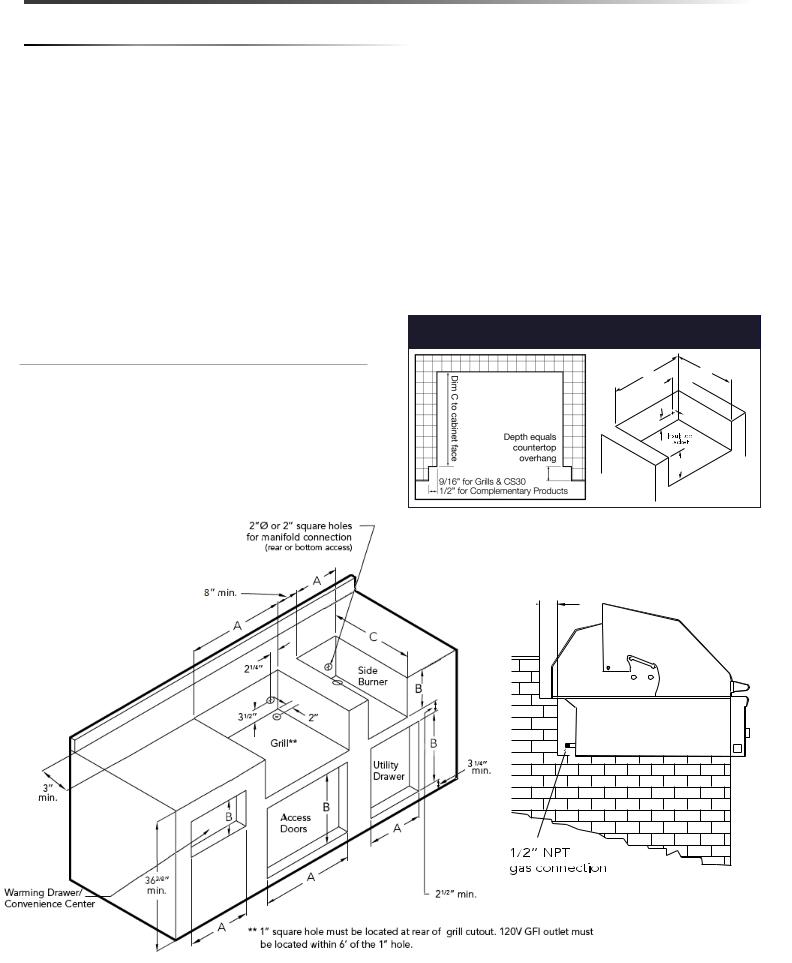
SPECIFICATIONS & INSTALLATION
The guides, measurements and dimensions detailed below are designated to assist you with planning your outdoor kitchen. NOTE: Due to continuing product innovation, specifications are subject to change without notice.
IMPORTANT: Please reference the Care & Use / Installation manual for details on gas plumbing requirements, electrical specifications and the proper installation of your outdoor kitchen equipment. This manual can be downloaded from our website at www.vikingrange.com.
GRILLS
MODEL |
A |
B |
C |
|
|
|
|
VQGI5300 |
29.00 |
10.88 |
24.50 |
|
|
|
|
VQGI5360 |
35.00 |
10.13 |
22.00 |
|
|
|
|
VQGI5420 |
41.00 |
10.88 |
24.50 |
|
|
|
|
VQGI5540 |
53.00 |
10.88 |
24.50 |
COMPLEMENTARY PRODUCTS
SIDE BURNERS
MODEL A B C
VQGSB5130 |
12.13 |
10.63 |
24.50 |
|
|
|
|
|
|
VQGPB5200 |
19.00 |
10.63 |
22.00 |
|
WARMING DRAWERS |
|
|
|
|
MODEL |
A |
B |
C |
|
|
|
|
|
|
VQEWD5300 |
28.50 |
10.00 |
20.50 |
|
|
|
|
|
|
VQEWD4200 |
40.25 |
19.38 |
24.50 |
|
|
|
|
|
|
WITH INSULATED JACKET INSTALLED
MODEL |
A |
B |
C |
|
|
|
|
VIJ30 |
36.00 |
11.63 |
26.50 |
VIJ36 |
42.00 |
11.63 |
24.00 |
VIJ42 |
48.00 |
11.63 |
26.50 |
VIJ54 |
60.00 |
11.63 |
26.50 |
COUNTER TOP NOTCH DETAIL
Only required if island counter top overhangs the face of the island
A  C
C
5”
4.5” 
 3”
3”
B
3”




CARE & USE/INSTALLATION | 9
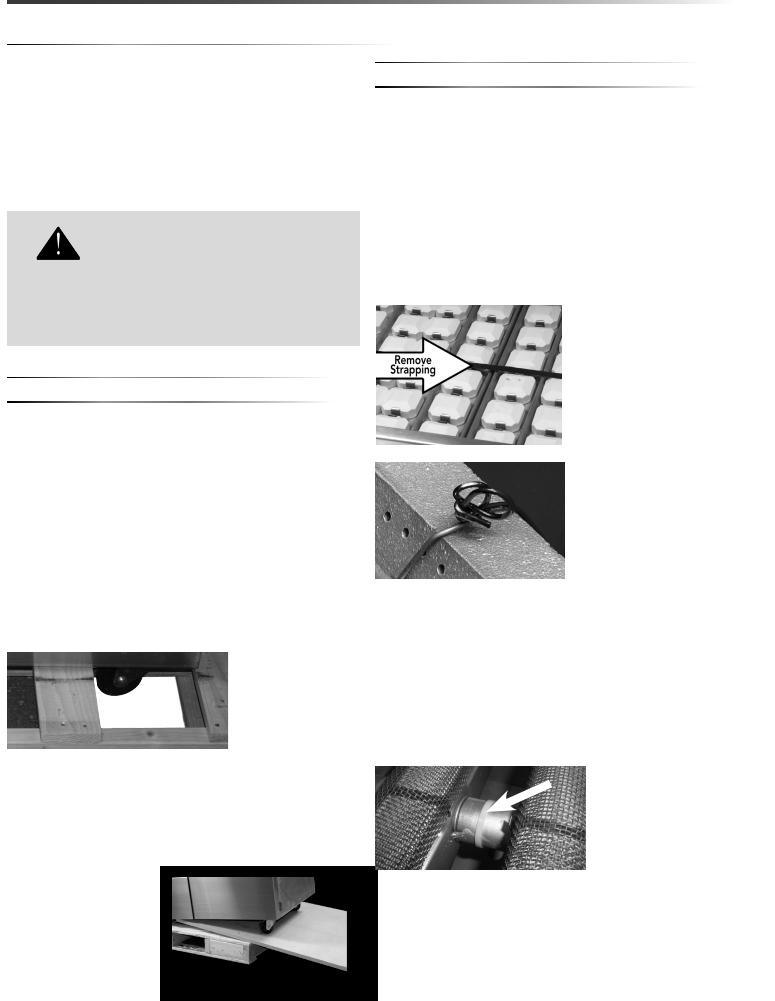
UNPACKING & ASSEMBLY
The grill arrives nearly ready to use and requires only minor assembly.
By carefully following the uncrating and unpacking steps, you will improve your first experience with the grill.
Shipping weight on smaller units is app. 300 pounds and larger units may weigh over 500 pounds.
WARNING:
EXCESSIVE WEIGHT HAZARD!
Use two or more people to move or install this unit. Failure to follow this instruction can result in back or other personal injuries.
CRATE & CARTON
•IMPORTANT! Do not remove staples around the top of the carton. These staples hold a wooden pallet in place inside the carton that protects the unit from damage.
Removing these staples may cause the pallet to fall on the top of grill.
How to Remove the Carton
•Cut the main strap holding the grill to the pallet.
•Remove the staples at the bottom of the carton.
•Lift off the carton.
•With assistance, remove the grill from the pallet and place into desired location.
Grill will not slide directly off pallet.
The wheels sit down in the gaps of the shipping crate so that the grill can sit safely and solidly on the crate during shipping. The grill cannot be slid directly off of the pallet.
One way to safely move the grill off of the pallet is by lifting one end of the grill high enough to place a ramp under the wheel and then lift the
other end while rolling the grill off of the pallet.
INTERIOR PACKING
Viking Range, LLC uses sturdy tie-down cables and straps to ensure your grill arrives at your home in the same condition that it left our factory. BE SURE YOU HAVE REMOVED ALL TIE DOWNS BEFORE USING YOUR GRILL.
•Remove the white accessory box and wood packing, the grill racks, and remove any loose items from the firebox.
•Carefully cut the cable ties securing the warming rack and rotisserie spit (if equipped).
•Cut the strapping that secures the briquette trays and carefully lift them out, front first.
Make sure you remember to remove the tie-downs on the burners.
•On Trident™ models, cut and remove ties from the burner partition on the left side of the Trident™ burner.
•Ensure that all burners are properly seated on the burner valve orifice and sitting level with the legs in the frame slots and no side-to-side movement.
10 | CARE & USE/INSTALLATION
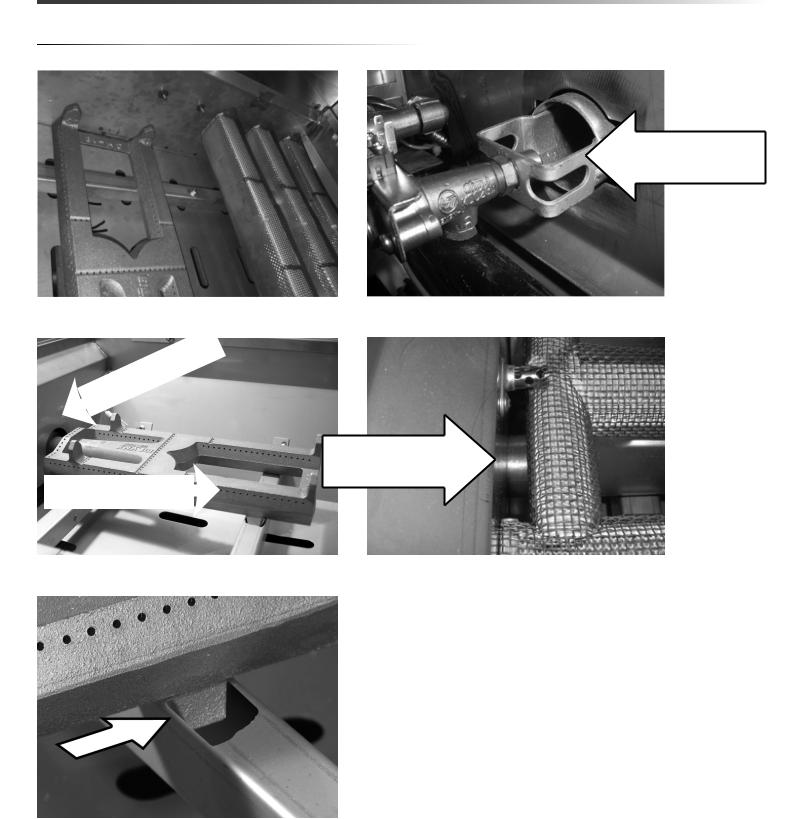
UNPACKING & ASSEMBLY ...continued
Heat Shield Removed,
Orifice/Venturi Position
way allthe Orificetheventuri into
Inside View, Orifice all the way into venturi
Legs in slot Burner sitting flat
CARE & USE/INSTALLATION | 11

GAS CONNECTIONS
 WARNING
WARNING
NEVER CONNECT A GAS LINE DIRECTLY TO THE GRILL. A PRESSURE REGULATOR MUST BE INSTALLED ON ALL GAS EQUIPMENT. ALL LOCAL CODES REQUIRE THAT THE PRESSURE REGULATOR SUPPLIED WITH YOUR GRILL IS USED. REMOVING OR FAILING TO INSTALL THE PRESSURE REGULATOR CAN RESULT IN FIRE AND SERIOUS PERSONAL INJURY AND WILL VOID THE WARRANTY.
The grill is factory set to use either propane (LP) or natural gas (NAT). It is critical that the gas you use matches that which the grill was set up for. You can verify that by checking the rating plate.
The Rating plate lists serial numbers, model numbers and gas type. This one is underneath the drip tray.
The rating plate is located in one or more of the following places:
•Attached to the underside of the drip tray
•On the heat shield behind the front panel
Ensure that the gas supplied meets with the minimum pressure requirements. Do not operate the grill on any gas other than that for which the grill has been set.
Fuel |
WC Max Inlet |
WC Min Under |
|
|
Full Load |
Nat Gas |
7 in |
4 in |
LP |
14 in |
11 in |
|
|
|
Water Column Requirements
Both the regulator and the manifold orifices have been tuned for the type of gas specified on the rating plate.
Converting to a different type of gas requires a conversion kit, available from your dealer and must be installed by a qualified technician.
All installation and all installation parts must conform to local codes with the National Electrical Code, ANSI Z223.1/ NFPA 70 latest edition and the National Fuel Gas Code, ANSI Z223.1/NFPA 54 in the U.S. and CGA-B149.1/.2 in Canada.
Canadian installations must conform to CGA-B149.1/.2 natural gas/propane installation code. (Canada)
NATURAL GAS
Viking Range, LLC recommends that only qualified professionals perform the required plumbing on this product.
To ensure satisfactory performance, the gas supply line must be sized to accommodate the total BTU requirements of all the gas-fired equipment that will be connected to that line.
In no case should pipe less than 3/4” inside diameter or 1” outside diameter ever be used to connect this product.
•Calculate the total BTU output of all equipment and refer to “INDEX: Gas Supply Line Runs” for allowable run distances for ¾ inch pipe. Failure to meet these minimum requirements may reduce performance of the grill and any other appliances running on that supply line.
•Always keep supply line runs as short as possible. (See INDEX: “BTU Output” for specific model outputs)
•A gas shut-off valve must be installed in an easily accessible location by a qualified plumber.
•Keep threading compound off of the first two pipe threads to avoid having any small pieces of compound break loose and clog a burner valve or orifice. Do not use threading compound on any flare fittings.
For built-in installations, it is recommended that any flexible pipe used be kept as short as possible. (See INDEX: “Gas Connections” for typical permanent hook up.)
Keep last two threads clean
12 | CARE & USE/INSTALLATION

GAS CONNECTIONS ...continued
For freestanding units using natural gas, using a metal flex hose is recommended.
This is available at your local hardware store or from your dealer.
LP GAS
Grills set up for LP gas come equipped with an LP hose/ regulator assembly for connection to a standard 20 lb. LP cylinder. (Type 1). All fittings necessary to attach the assembly to the grill are included.
LP cylinder with type 1 valve connection
Permanently plumbed LP connections, such as those in line with a bulk cylinder, require a 4/11 regulator.
When using the 4/11 regulator you must ensure that it is set for the proper fuel type. This is done by removing the regulator cap and gasket and looking at the bottom of the plunger to see what fuel type is visible. This is the regulator fuel setting. NAT is for natural gas and LP is for propane gas. The LP setting can be further identified by the large diameter disk on the bottom of the plunger. To
change from one gas to the other simply push the plunger to the side to snap it out of the cap, turn the plunger so
it reads the desired gas type on the bottom, and push the plunger until it snaps back into place in the cap then replace the cap into the regulator.
Never connect an unregulated gas line to the grill.
 WARNING
WARNING
Do not change the regulator/hose assembly or use any other assembly than the one supplied with your grill.
Do not attempt to use a 5LP-A equipped regulator/hose assembly with a standard 510 POL cylinder/valve assembly.
Do not store a spare LP-gas cylinder under or near this appliance.
Never fill the cylinder beyond 80 percent full.
If the information above is not followed exactly, a fire causing death or serious injury may occur.
LP Cylinder Requirements
The LP cylinder must be constructed and marked in accordance with the specifications for LP gas cylinders of the U.S. Department of Transportation (DOT) and designed for use with a Type 1 system only.
Cylinders of free standing grills must be secured using the provided cylinder retention system to avoid accidental movement.
When exchanging your cylinder for a refill, exchange only for a Type 1 20lb cylinder with an over-fill protection device.
Never use a cylinder with a damaged valve.
A dented or rusty LP cylinder may be hazardous and should be avoided. If in doubt, have it checked by your LP supplier.
Always check for leaks after every LP cylinder change. (See INDEX: “Leak Test” for further details.)
Always shut off the LP-gas supply at the cylinder when the grill is not in use.
Cylinders must be stored outdoors in a well-ventilated area out of the reach of children. If your grill is stored indoors, the LP cylinder must be stored outside.
LP Connections
Make sure the LP cylinder valve is fully closed. It is possible for the valve to be open without releasing gas but, as soon as you start connecting the regulator, gas will leak from the connection.
CARE & USE/INSTALLATION | 13
